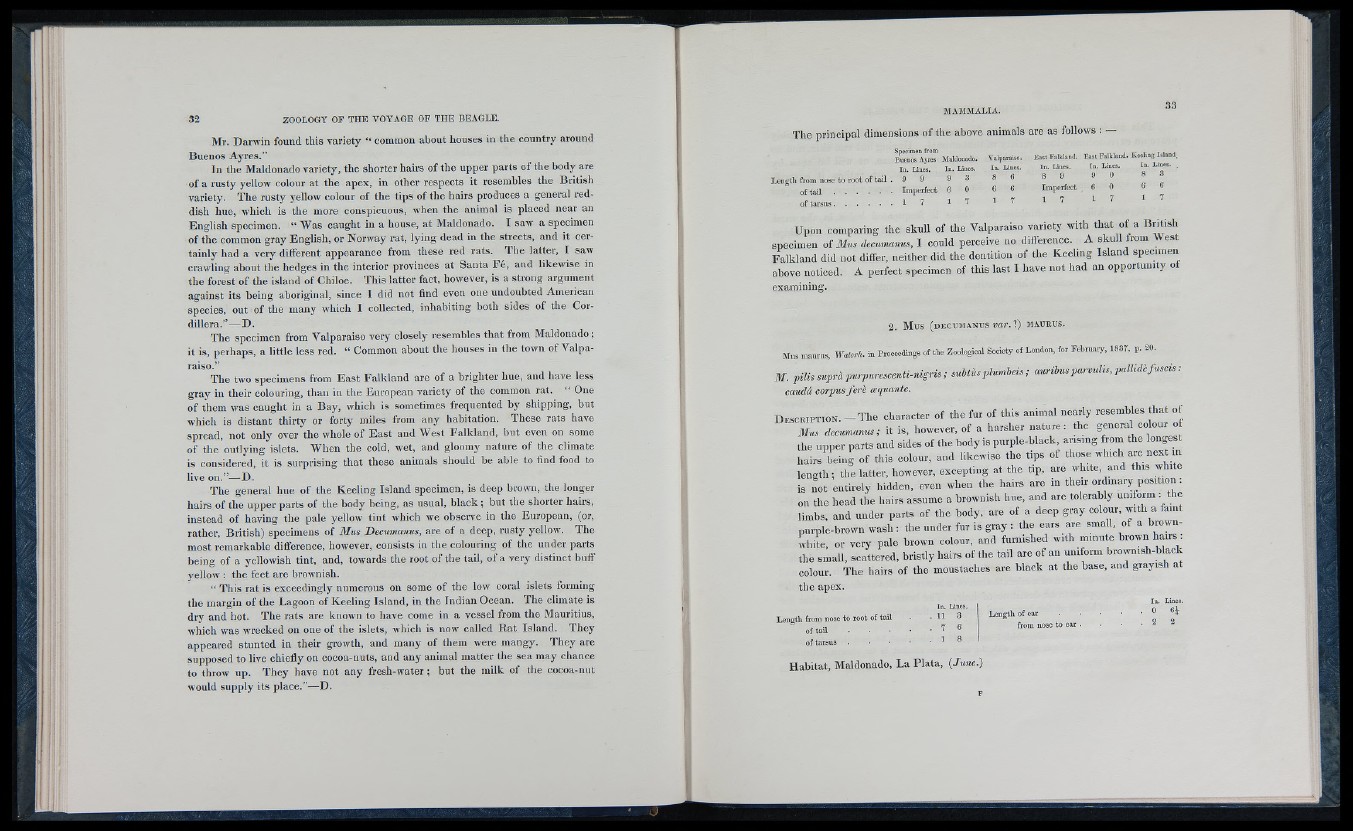
Mr. Darwin found this variety “ common about houses in the country around
Buenos Ayres.”
In the Maldonado variety, the shorter hairs of the upper parts of the body are
of a rusty yellow colour at the apex, in other respects it resembles the British
variety. The rusty yellow colour of the tips of the hairs produces a general reddish
hue, which is the more conspicuous, when the animal is placed near an
English specimen. “ Was caught in a house, at Maldonado. I saw a specimen
of the common gray English, or Norway rat, lying dead in the streets, and it certainly
had a very different appearance from these red rats. The latter, I saw
crawling about the hedges in the interior provinces at Santa F 6, and likewise in
the forest of the island of Chiloe. This latter fact, however, is a strong argument
against its being aboriginal, since I did not find even one undoubted American
species, out of the many which I collected, inhabiting both sides of the Cordillera."—
D.
The specimen from Valparaiso very closely resemhles that from Maldonado;
it is, perhaps, a little less red. “ Common about the houses in the town of Valpa-
raiso.”
The two specimens from East Falkland are of a brighter hue, and have less
gray in their colouring, than in the European variety of the common rat, “ One
of them was caught in a Bay, which is sometimes frequented by shipping, hut
which is distant thirty or forty miles from any habitation. These rats have
spread, not only over the whole of East and West Falkland, but even on some
of the outlying islets. When the cold, wet, and gloomy nature of the climate
is considered, it is surprising that these animals should be able to find food to
live on.”— D.
The general hue of the Keeling Island specimen, is deep brown, the longer
hairs of the upper parts of the body being, as usual, black ; but the shorter hairs,
instead of having the pale yellow tint which we observe in tlie European, (or,
rather, British) specimens of 3Ius Decumanus, are of a deep, rusty yellow. The
most remarkable difference, however, consists in tlie colouring of the under parts
being of a yellowish tint, and, towards the root of the tail, of a very distinct buff
yellow : the feet are brownish.
“ This rat is exceedingly numerous on some of the low coral islets forming
the margin of the Lagoon of Keeling Island, in the Indian Ocean. The climate is
dry and hot. The rats are known to have come in a vessel from the Mauritius,
which was wrecked on one of the islets, which is now called Rat Island. They
appeared stunted in their growth, and many of them were mangy. They are
supposed to live chiefly on cocoa-nuts, and any animal matter the sea may chance
to throw up. They have not any fresh-water; but the milk of the cocoa-nut
would supply its place.”—D.
The principal dimensions of the above animals are as follows : —
Specimen from
Buenos Ayres Maldonado.
In. Lines. In. Lincs.
Xjcngtli from nose to root of tail . 9 9 9 3
of t a i l ...............................Imperfect 6 0
of tarsu s...............................1 7 1 7
Valparaiso.
In. Lines.
8 6
East Falkland. East Falkland. Keeling Island.
In. Lines. In. Lines. In. Lines. .
Imperfect
1 7
Upon comparing the skull of the Valparaiso variety with that of a Brfiish
specimen of decumanus, I could perceive no difference. A skull from West
Falkland did not differ, neither did the dentition of the Keeling Island specimen
above noticed. A perfect specimen of this last I have not had an opportunity of
examining.
2 . Mus ( d e c u m a n u s m r . ?) m a u r u s .
Mrs nrauius, T lW i . in Proceedings ot the Zoologienl Society ot London, to, Fchrnary, 183T, p. 20.
M. pilis suprà purpurescenti-nigris ; subtùs plumbeis ; auribus parvulis, pallidè fuscis :
caudâ corpus ferè aquante.
D e s c e i p t i o n . - The character of the fur of this animal nearly resemhles that of
SIus decumanus; it is, however, of a harsher nature: ffie general colour of
the upper parts and sides of the body is purple-black, arising from the longest
hairs being of this colour, and likewise the tips of those which are next in
leno-th ; the latter, however, excepting at the tip, are white, and this white
is not entirely hidden, even when the hairs are in their ordinary positron :
on the head the hairs assume a brownish hue, and are tolerably uniform : the
limbs, and under parts of the body, are of a deep gray colour, with a famt
purple-brown wash : the under fur is gray : the ears are small, of a brown-
white, or very pale brown colour, and furnished with minute brown hairs :
the small, scattered, bristly hairs of the tail are of an uniform brownish-black
colour. The hairs of the moustaches are black at the base, and grayish at
the apex.
Length from noS'
of tail
of tarsus
Ì to root of tail
In. Lines.
. 11 3
. 7 6
. 1 8
Length of ear
from nose to ear .
In. Lines.
0 64
2 2
Habitat, Maldonado, La Plata, (June.)